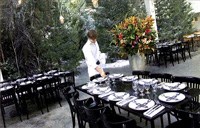
Top stories


Marketing & MediaCammy Msimango on finding her footing in South Africa’s fast-moving digital newsroom
Esther Tomorrow, MDNTV 21 hours




More news



One reason provided for their recent rise has been the knock-on recessionary effect that has seen hundreds of stores left empty and boarded up across the country. Personally, though, we prefer to take the creative high ground that brands are looking to engage consumers in new and unexpected environments to create memorable brand experiences.
Whether you're a fan of them or not, the pop-up store craze is gaining momentum and can no longer be ignored. For this reason, we've developed our own little Stretch DIY Pop-Up Store model to help spread the message of temporary brand retail love.

Having started out in 1996 as a solution for a small LA clothing brand to generate hype about limited edition products, pop-up stores have emerged to meet different commercial and brand goals. These include increasing sales (particularly relevant for smaller brands, such as pop-up restaurants trying to avoid high street rentals), testing the market, launching a product, raising brand awareness and creating PR buzz.
NB: It's worth bearing in mind that not all pop-up stores need to be retail pop-up stores. Some might, in fact, offer no retail experience whatsoever, with the emphasis placed on product/service consumption and in turn brand awareness and brand building. The need for retail will depend on the objectives the brands are trying to achieve.
To pop correctly, it's crucial brands identify why they 'want to pop' to ensure they don't put the cart before the proverbial trend horse.

Choosing when to pop is a strategic decision, get it wrong and you risk hearing crickets instead of footfall traffic. Know your population! Consumers will no doubt appreciate the thought that went into not only giving them a brand experience but also leveraging off a personal insight garnered during research.
Examples of this enabling function include:

Once you've identified what you are looking to achieve by your pop-up campaign and how it's relevant to your consumer, there are three main store variations from which to choose:
Your selection of chosen pop-up form should ideally be driven by your exposure objective. In other words, are you looking at maximum consumer interactions or is your campaign focused on ROI through digital and PR exposure?
Pop-up stores are great in theory but do bring with them some important production considerations. Ignore these at your peril!
A few very important production planning phases must not be missed:
Pop-up stores will be judged on their ability to generate talkability through unexpected innovation.
While brand managers across South Africa are no doubt scrounging around for extra budget to make them happen, there needs to be perspective and a clear plan in place, from inception to execution. These ventures need to be treated as stand-alone marketing campaigns with clear objectives and measurables in place.
Get it right and you'll be on even the most sceptical of consumers' lips for having the retail ability to snap, crackle and, well, you know what.
Mike Silver, director of Stretch Experiential Marketing, also contributed to the writing of this how-to guide.
